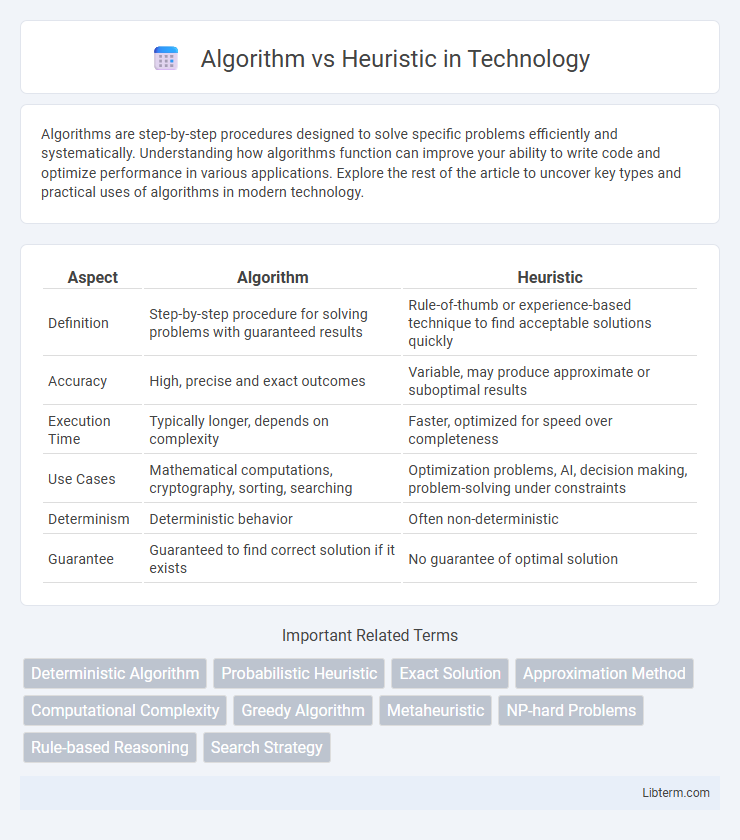Algorithms are step-by-step procedures designed to solve specific problems efficiently and systematically. Understanding how algorithms function can improve your ability to write code and optimize performance in various applications. Explore the rest of the article to uncover key types and practical uses of algorithms in modern technology.
Table of Comparison
| Aspect | Algorithm | Heuristic |
|---|---|---|
| Definition | Step-by-step procedure for solving problems with guaranteed results | Rule-of-thumb or experience-based technique to find acceptable solutions quickly |
| Accuracy | High, precise and exact outcomes | Variable, may produce approximate or suboptimal results |
| Execution Time | Typically longer, depends on complexity | Faster, optimized for speed over completeness |
| Use Cases | Mathematical computations, cryptography, sorting, searching | Optimization problems, AI, decision making, problem-solving under constraints |
| Determinism | Deterministic behavior | Often non-deterministic |
| Guarantee | Guaranteed to find correct solution if it exists | No guarantee of optimal solution |
Introduction to Algorithms and Heuristics
Algorithms are step-by-step, well-defined procedures designed to solve problems with guaranteed accuracy and efficiency, commonly explored in computational theory and computer science. Heuristics refer to experience-based techniques or intuitive rules that provide approximate solutions faster but without guaranteed optimality, often used in complex or uncertain problem domains. Understanding the distinction between algorithms and heuristics is crucial in fields like artificial intelligence and optimization, where balancing precision and speed impacts performance.
Defining Algorithms: Precision and Process
Algorithms are defined by their precise step-by-step procedures that guarantee a specific outcome when followed correctly. They consist of clear, unambiguous instructions designed to solve problems through logical sequences and systematic operations. Precision in algorithms ensures replicability and accuracy, making them essential in fields such as computer science, mathematics, and data processing.
Understanding Heuristics: Flexibility and Approximation
Heuristics provide flexible problem-solving strategies that prioritize speed and practicality over exactness, enabling efficient decision-making in complex or uncertain environments. Unlike rigid algorithms that guarantee optimal solutions through exhaustive search and defined steps, heuristics rely on approximation and rules of thumb to produce satisfactory, though not always perfect, results. This adaptability makes heuristics essential in domains such as artificial intelligence, optimization, and cognitive psychology where computational resources or complete information are limited.
Key Differences Between Algorithms and Heuristics
Algorithms are step-by-step procedures that guarantee a solution through systematic and logical operations, often used in computer science and mathematics for precise problem-solving. Heuristics are rule-of-thumb strategies or mental shortcuts that provide approximate solutions more quickly but without guaranteed accuracy, commonly applied in situations with complex or incomplete information. Key differences include algorithms' emphasis on accuracy and determinism versus heuristics' focus on speed and efficiency in decision-making processes.
When to Use Algorithms vs. Heuristics
Algorithms are ideal for problems requiring precise solutions with guaranteed accuracy, such as mathematical computations or sorting tasks, where every step follows a defined procedure. Heuristics are better suited for complex, uncertain environments like decision-making or problem-solving scenarios where speed and efficiency take precedence over perfect accuracy. Use algorithms when accuracy and reproducibility are critical, and heuristics when quick, approximate solutions suffice under time or information constraints.
Pros and Cons of Algorithms
Algorithms provide precise, step-by-step procedures that guarantee a correct and optimal solution when properly designed, ensuring reliability and consistency in problem-solving across various applications such as computing and mathematics. They may require significant computational resources and time, especially for complex problems, which can limit their practicality in real-time or large-scale scenarios. The rigid structure of algorithms can reduce flexibility, making them less effective for problems with uncertain or incomplete data compared to heuristic methods.
Advantages and Limitations of Heuristics
Heuristics offer rapid decision-making by simplifying complex problems through experience-based techniques, making them advantageous for time-sensitive or resource-limited situations. They provide flexibility and adaptability in dynamic environments where precise algorithms may be infeasible or computationally expensive. However, heuristics can lead to suboptimal or biased outcomes due to their approximate nature, lacking the guaranteed accuracy and consistency of formal algorithms.
Real-World Examples of Algorithms and Heuristics
Algorithms in real-world applications include sorting algorithms like QuickSort used in database management systems to efficiently organize large data sets, and Dijkstra's algorithm deployed in GPS navigation for finding the shortest path. Heuristics appear in scenarios such as medical diagnosis where doctors use rule-of-thumb approaches to make rapid decisions under uncertainty, and in online shopping recommendations that utilize heuristic methods to suggest products based on user behavior patterns. Both algorithms and heuristics optimize problem-solving, but algorithms guarantee precision while heuristics prioritize speed and practicality in complex, uncertain environments.
Impact on Problem-Solving and Decision-Making
Algorithms provide precise, step-by-step procedures that guarantee a solution to a well-defined problem, enhancing accuracy and consistency in decision-making. Heuristics offer approximate, experience-based methods that expedite problem-solving in complex or uncertain situations, improving efficiency but potentially sacrificing accuracy. The impact on problem-solving lies in balancing the thoroughness of algorithms with the adaptability of heuristics to achieve optimal decisions under varying constraints.
Future Trends: Combining Algorithms and Heuristics
Future trends in problem-solving emphasize the integration of algorithms and heuristics to enhance efficiency and accuracy in complex systems. Hybrid models leverage algorithmic precision with heuristic flexibility, enabling adaptive learning and real-time decision-making in artificial intelligence and big data analytics. This fusion drives advancements in autonomous systems, optimization tasks, and personalized technology solutions.
Algorithm Infographic

 libterm.com
libterm.com